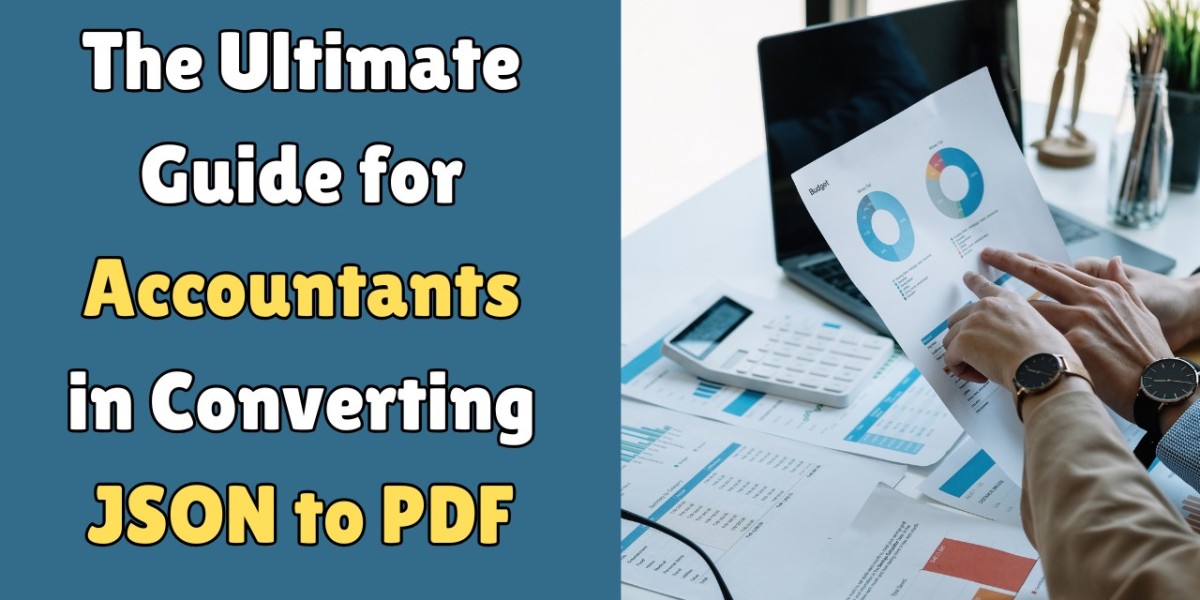Writing Highlights
PDFs ensure easy sharing and compatibility.
Structured PDFs enhance financial reporting.
Automation saves time and reduces errors.
PDFs streamline audits and compliance.
Charts and tables improve data clarity.
PDFs enhance security and access control.
Automation frees time for analysis.
In accounting and finance, information is the crux of all decision-making as well as report generation. As such, for accountants to produce reports accurately, track performance, and fulfill regulatory requirements, they need correctly structured information in good time. With the continued growth in processed data, so has the requirement to manage that information efficiently and effectively.
Effective data management is more than just collecting and storing information - it is the process of converting unprocessed data into meaningful information, especially about complex data formats such as JSON, usually applied in financial software and systems for data exchange purposes. However, even though JSON may be efficient for machines, it doesn't seem to make user-friendly data interpretation for accountants and other stakeholders, who need to interpret the data quickly.
Transforming structured data, such as JSON, into a more user-friendly and visually appealing format like PDF can be transformative. PDF files are simple to share, print, and display, making them perfect for financial reports, tax submissions, and client interactions. By transforming JSON into PDF, accountants can guarantee that information is displayed in a clear, professional manner that’s simple for anyone to comprehend.
Why Convert JSON to PDF?

By eliminating the possibility of errors and also making the data more accessible, accountants can improve both productivity and the accuracy of their financial reports.
User-Friendliness and Presentation
JSON data, while efficient for machines, is not always the most accessible format for accountants or stakeholders. As it organizes information well for systems, the same information will appear as a series of cryptic codes or text strings if viewed directly. Converting JSON to PDF format helps the data appear more structured and readable with headings, bullet points, and formatted tables. It not only makes the data easier to digest but also allows accountants to present financial data in a professional format that is easy for clients or other non-technical stakeholders to understand.
Accessibility and Ease of Sharing
PDFs are accepted across most devices and operating systems, which makes them ideal for sharing accounting reports. While JSON might require some software or programming knowledge to interpret, PDFs can be opened on nearly any device without losing their formatting. This ensures that the recipient always sees the document as intended, whether it is for internal review, client sharing, or submission to regulatory bodies. This level of access and ease of sharing is key for accountants who need to ensure that reports are distributed uniformly and universally.
Streamlined Audits and Compliance Reporting
One of the key reasons accountants convert JSON to PDF is for compliance reporting and audits. Reports are often required to be in PDF format due to preservation and consistency. JSON lacks the level of visual clarity that is required for official documents, even if it's structured. Converting JSON to PDF ensures that the data is formatted according to industry standards, making it suitable for audit trails, tax filings, or regulatory submissions. This streamlined process helps accountants prepare documents that meet compliance guidelines, ensuring they avoid any issues with oversight authorities.
Reducing Errors in Data Interpretation
Converting JSON to PDF helps reduce the risk of misinterpreting raw data. The interpretation of JSON files often involves parsing and interpreting, which can be prone to human error, especially when the data is complex. Automated conversion tools can eliminate the inconsistencies and errors that might occur during manual interpretation. According to a 2022 report by the Association of Chartered Certified Accountants (ACCA), organizations that have embraced automation in their financial processes can reduce manual errors by up to 90% and improve reporting speed by 70%. Using conversion tools means that accountants will ensure the data is properly presented and professionally, thus having a reduced possibility of costly errors during audits or client reviews.
Benefits of Using a JSON to PDF Converter for Accountants

Automated tools are used for such conversions, thereby allowing accountants to be productive while maintaining accuracy and professionalism.
Time-Saving Aspects of Automating Data Conversion
The time accountants can save with the automation of converting JSON data to PDF is substantial. In place of tedious extraction and organizing of information from raw JSON files, a JSON to PDF converter free tool would make the whole process easy and fast. Automating the whole process allows the accountant to get professional-looking reports quickly without taking time to format them. With all this saved time, accountants can spend more time analyzing data, improving their relationships with clients, and adhering to compliance regulations.
Reduces Errors in Manual Conversions
Manual conversion of JSON data to readable format is risky and prone to errors, especially when dealing with large or complex datasets. The smallest mistake could be a misplaced decimal point or an omitted value, which in turn can mean a lot financially. Using a JSON to PDF converter eliminates human error in converting the data since it is all automated. In this way, data is always presented accurately with consistency, keeping financial reports on the right track and avoiding costly mistakes.
Easier Presentation to Stakeholders and Clients
Presenting financial data in a more digestible format is crucial when communicating with stakeholders, clients, or auditors. Although JSON files are structured, they are not ideal for presentation. The information will be transformed into a PDF format, allowing the accountants to organize and display the data in a more aesthetically pleasing way. The PDF format, featuring tables, charts, and headers, enhances the ability of stakeholders and clients to quickly comprehend the data. This may lead to the improvement of professionalism in the presentation, satisfaction of the client, and better decision-making.
Simplified Workflow for Collaborative Teams
Accountants work in teams. They might be working together with other experts such as auditors, tax consultants, or business analysts. Transforming JSON data into a widely accessible format like PDF facilitates better sharing and collaboration among team members regarding the data. PDFs can be effortlessly opened, viewed, and annotated on various platforms, guaranteeing that all participants in the project can access identical information without facing compatibility problems. This simplifies the workflow, enhancing productivity and facilitating collaboration more seamlessly.
Improved Security and Document Preservation
Financial data is sensitive, and security is very important. PDFs have stronger security features than raw JSON files. The transformation of JSON data into a password-protected or encrypted PDF will enable accountants to avoid any unauthorized access to financial information. Moreover, PDFs are less prone to change and deterioration compared to normal files, which makes them a safer and more reliable format for saving important documents.
Better Compliance and Audit Trails
Industry regulations usually demand that financial data be organized, easily accessible, and presented in a clear format. The conversion of JSON to PDF ensures that reports meet these standards. PDF files are also ideal for maintaining an audit trail because they can be easily stored, indexed, and retrieved when needed. This makes it easier to comply with audits or regulatory checks, offering greater peace of mind to accountants and their clients.
Supports Archiving and Retrieval
When PDFed, the financial reports become archived in an efficient and orderly manner. This is because the PDF files can be easily searchable, making it easier for the accountants to find specific reports or data points when needed. This is highly helpful during the tax season or audits and in case clients want historical financial information. Archiving JSON data in PDFs guarantees that critical reports are not only well-organized but also retrievable and reviewed in the future.
Best Practices for Converting JSON to PDF for Accounting Reports

By following these best practices, you will ensure that the conversion of JSON to PDF yields a well-structured, readable, and professional accounting report easily understood by stakeholders.
Pre-format Your JSON Data for Clarity
Before converting the JSON to PDF, make sure the data is clean and structured so that it can be read easily. Remove all unnecessary elements or nested structures that may confuse the reader. Make your JSON neat by categorizing data into logical groups—like income, expenses, and assets so that each category can be easily represented in the PDF. Use consistent naming conventions for fields and make the data concise but detailed enough to provide all the information.
Clean and Organize Data for Readability
Once your JSON data is properly formatted, focus on eliminating any extraneous information or redundant fields that may clutter the PDF output. For example, if your JSON contains multiple transaction entries, ensure that fields like transaction dates, amounts, and categories are clearly labeled. This organization reduces ambiguity and makes the data easier to interpret in the final PDF document.
Use Headers and Subheadings for Clear Structure
When converting JSON data to PDF, headers and subheadings are essential for breaking the document into digestible sections. Think about structuring your PDF into distinct sections, like "Income", "Costs", "Possessions", and "Debts". This method not only boosts the visual attractiveness of the document but also increases its practicality by enabling accountants and stakeholders to move through the report with greater ease. Include bold and slightly larger fonts for section headers, and use subheadings for further subdivisions.
Add tables for financial data
Tables are an integral part of accounting reports. For clarity, organize numerical data such as income statements, balance sheets, and tax filings into tables. These tables should clearly show financial figures with appropriate column headers such as "Account", "Debit", "Credit", and "Balance". If your JSON data contains transactional or account data, mapping it into rows and columns will make it much more readable and actionable in PDF format.
Add Visual Elements: Charts and Graphs
Adding Charts or Graphs to PDFs for better graphical representation For non-technical stakeholder purposes especially when data have trends such as monthly revenues, and yearly expenditures: charts like pie charts, and line graphs give a quick easier-to-read approach to data presented. Many converters free to the public PDF from JSON would allow for the integration of charts without having to download any add-ons.
Concluding Remarks
Converting JSON to PDF helps streamline financial reports as it takes unstructured, machine-readable data and structures them into readable and professional documents, which are hence easier to interpret and share. To an accountant, this smoothness improves readability, especially in collaboration as fewer errors are made, and there is support for audit and regulatory requirements.
Accountants, therefore, better enhance the making of reports when using organized data, usage of tables and charts, and consistent structure. Levers the use of automation tools in converting it saves time and increases precision, enabling the professional to gain maximum time for financial analysis and decision-making instead of formatting data manually.









